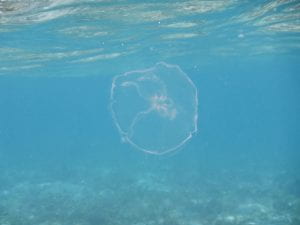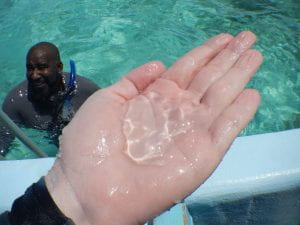I climbed back into the boat, seawater streaming off me in every direction. After taking a quick look around, I flopped over to reclaim my seat, but it already had an occupant. A giant lobster was lying smugly across the bench. I did a double take and just stood there, unsure of what to do, until someone casually picked it up and handed it to me. I took it, noticed it was hollow, and asked, “Uhh… what’s wrong with it?” Turns out, it was just an empty shell, so it sat on my lab for the rest of the way back. Lobsters molt, or leave behind their exoskeletons many times as they grow, until one day they grow too big to slip out, and that’s when their life ends.
(Lucky Lobster – 05/28/25)
Today, we designed a research project to measure the effectiveness of Marine Protected Areas (MPAs) – government-protected zones – at maintaining marine diversity and reef health. As a class, we chose to focus on species diversity and algal growth as indicators of reef health. We visited a mix of MPA and non-MPA sites, randomly selecting reef patches to photograph for analysis back in the island’s wet lab.
Sohee and I stuck together to collect data; I’d find the areas and she would snap the shots. We created a new hand-holding buddy system to keep from drifting apart for some efficiency and peace of mind. We were it in together, exploring the reef ecosystems while battling mild seasickness and weaving around jellyfish. Luckily, all the jellies we encountered were Moon Jellyfish, whose stings are mild and considered harmless to humans. Though, we didn’t know that at the time.
We came across 3 stoplight parrotfish and a blue tang, excitedly shaking each other’s hands to point them out. In both MPAs and non-MPAs, sponges bedazzled the sea floor, latching onto rocks or coral. Any unease vanished as I duck-dived down like a mermaid for a closer look. I found more yellow rope sponges, scattered pore rope sponges, boring sponges, and even fire sponges, which have a nasty sting. And as a final treat, back in the boat, lobster in hand, our class watched in awe as a curious dolphin swam around us, interested in our strange, oversized, fish-like vessel.
(Duck Diving – 05/28/25)
(So Many Sponges – 05/28/25)
Back in the lab, we didn’t see much of a difference in reef health between the different sites, but we noticed that MPAs had a slightly higher average species count, suggesting they might offer a healthier and more supportive environment.
After wrapping up our research project, we all sat by the dock to catch the breeze and escape the heat. Claire and I lay on our stomachs, peering at the ocean below through the gaps between the wooden planks and shielding our faces from the sun. The possibilities of what we might see felt endless, maybe a nurse shark, or maybe even a dolphin.
Peace Out,
Lily H. 🙂 2025






